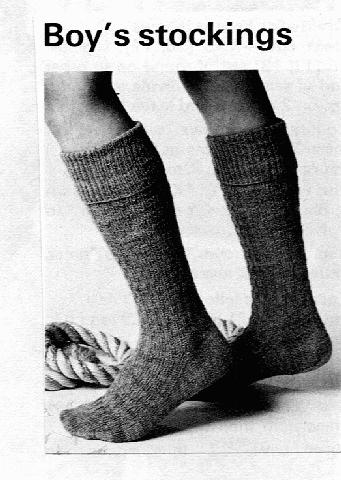
The stockings and socks worn by boys have changed significantly
over time.
Over the knee white stockings were worn with knee britches during
much
of
the 18th century. Short ankle socks, often white, were generally
worn by boys for dress at
the beginning of the 19th Century. Boys in dressy
skeleton suits often wore
slippers, white ankle socks and pantalettes or long pantaloons. As boys grew out of
skeleton suits and smocks it was common for boys through mid-century
to wear various styles of jackets,
primarily with long trousers or pantaloons. After mid-century it became
increasingly common for younger boys to wear
knee pants. Boys in knee pants during the mid-19th century, wore long dark-colored
over the knee stockings. Even the fanciest Little Lord
Fauntleroy suits were usually worn with dark stockings during the 1880s and
1890s. Long stockings were held up with
a kind of waist belt with clasps. At the end of the 19th century some
boys wore stockings with horizontal strips. Some mothers in the early 20th century turbned to white stockings and socks
when dressing boys in Fauntleroy suits or other dressy outfits instead
of the dark socks common before the turn of the century. As boys after
World War I increasingly dressed in knickers or short pants,
knee socks
became common. British boys who referred to knee socks as turn over top
socks, often wore grey knee socks with their school
colors or a pattern at the top. American boys liked to wear argyles
with their knickers. After World War II, American boys generally wore
ankle socks with argyles or horizontal patterns. White atletic socks were worn with
shorts or for port. During the late 1970s, tube socks, or long white atletic socks with color bands
at the top became popular as American boys showed greater interest
in basketball and soccer.
Note: Space limitations do not permit me to provide more
information on
boys' stockings and socks or historical photograhs.
There is,
however, additional information and many historical photographs
on the expanded Boys Historical Clothing web site. For details click
here >>>>>>
.
1880s: An American Department store (Lord & Taylor) indicated
in 1881 that:
Childrens' stockings are usually ribbed and are as fanciful as possible. The foot in fine stripe of gay color is separated by the plainer top by bands of gold-color, blue, or dull red. Black stockings are liked for children with bright Madras stripes of blue, red, or yellow, or strewn with small polka dots. Half hose or socks are preferred during the warm weather for little ones under five. They are in liske-thread, in the color, and often in open-work patterns.
Types
White socks: Lord & Tayor in 1881 offered white socks
for children in sizes 4 in to 6 1/2 - 7 in, both full length and 3/4
hose.
Plain color socks: Lord & Tayor in 1881 offered plain colored socks
for children in sizes 4 in to 7 in, both full length and 3/4
hose.
Striped socks: Lord & Tayor in 1881 offered striped
and fancy striped socks
for children in sizes 4 in to 6 1/2 - 7 in, both full length and 3/4
hose.
Silk hose: Lord & Tayor in 1881 offered 1/2 and 3/4 silk
hose in both sandal-lace and plain colors
for children in sizes 4 in to 6 in.
Navigate the Historic Boys' Clothing Web Site:
[Introduction]
[Chronologies]
[Style Index]
[Biographies]
[Bibliographies]
[Contributions]
[Boys' Clothing Home]
Navigate the Historic Boys' Clothing Web chronological pages:
[1700s]
[1800s]
[1880s]
[1900s]
[1920s]
[1950s]
[1970s]
Navigate the Historic Boys' Clothing Web style pages:
[Knee pants]
[Knickers]
[Short pants suits]
[Kilts]
[Sailor suits]
[Shoes]
[Ring bearer/page costumes]
[Shortalls]